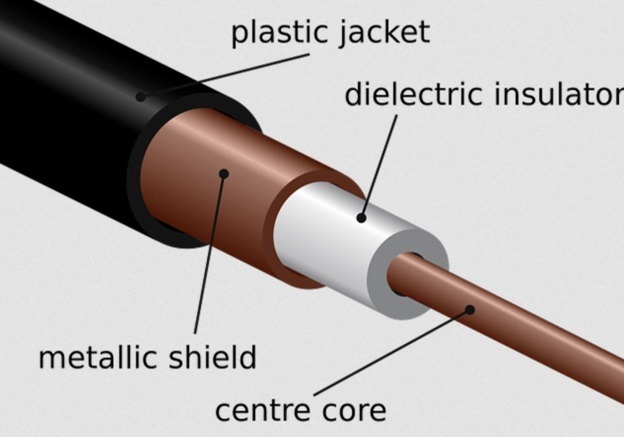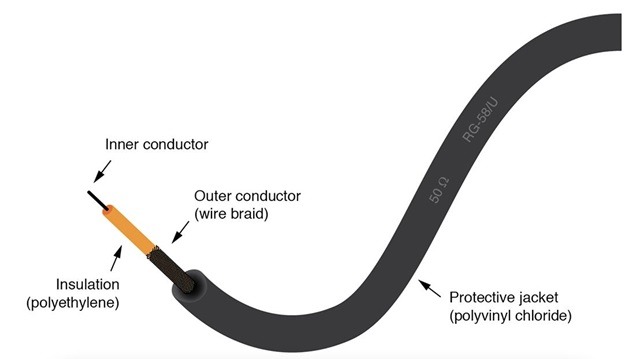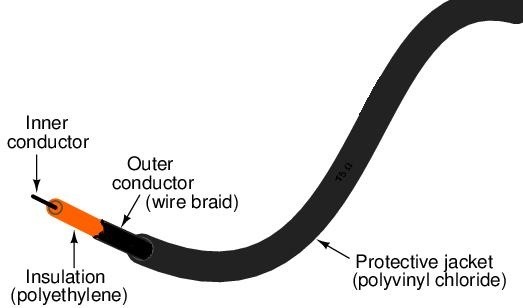Coaxial speaker cable is also known as coax audio cable. It is capable of sending high quality audio signals from a receiver/amplifier to speakers.
RCA coaxial cables can be used in music systems to connect externally powered subwoofers. Attaching your own connectors with the coaxial speaker cable could be tricky for most,as the process requires connectors cutting, removing shielding, winding and braiding into a single thread.
What Is Coaxial Cable?
Coax cables are extremely useful in transferring radio frequency (RF) signals from one device to another. These cables can transport and move audio, video, and digital data across large distances.
Along with the capability of traveling long distances, coax is also known for its excellent ability to reject interference. This RF spectrum spans an incredibly wide range of frequencies – from the upper limits of what is audible to humans up to the lower end of infrared frequency waves (30Hz-300GHz).
They simultaneously transmit signals through the center wire and the metal shield without any loss in the signal which is then converted into audio, images.
What Does A Coaxial Cable Look Like?
Coaxial cables transmit information in a variety of forms, from television to the internet. Each coaxial cable is composed of four core components-
- A core conductor that carries the high-frequency signal.
- Dielectric insulator made of plastic to separate it from the outer layers.
- A metal shield made of woven copper or aluminum wraps the insulator and rejects the external signals.
- A jacket or a rubber wrapper that further protects the complete configuration of the cable.
Copper is the material of choice when it comes to cable cores, due to its natural conductivity and durability. This can come in the form of copper-plated steel for thicker installations, or as stranded copper for more flexible applications.
Depending on where the cable will be used, an insulator can be made from any number of materials – from solid plastic to foam plastic, or even air with spacers.
Copper braided wire has become the industry standard in shielding for audio cables as it provides greater electrical efficiency than other materials, making it ideal for long runs and resisting interference.
When searching for a higher-quality cable, look out for options that contain two shields instead of one, with the combination of aluminum foil and a braided copper wire offering optimal protection from outside noise. Silver-plated braid is also occasionally used in place of traditional copper.
The final layer of an electrical cable is commonly known as the jacket. This jacket protects from factors such as weather, fire, and water that could damage the electrical wiring inside.
Different materials may be used to make the jacket depending on its purpose and environment. Most often this material is PVC (Polyvinyl Chloride), yet it can also be fire-resistant oxidation or ultraviolet light resistant, or even water-resistant.
Depending on the specific application, coaxial cables may appear in various lengths and thicknesses, as well as different colors.
Advantages And Disadvantages Of Coaxial Cables
Advantages
- Coaxial cables are less likely to contract electromagnetic and radio-frequency interference.
- This also permits signals up to 50MHz and greater to travel more efficiently along the wire.
- They provide faster transmission speeds and higher bandwidth capabilities, making them ideal for large volumes of data.
- Coaxial cables are cost-effective and simple to install while staying extremely durable.
Disadvantages
- A faulty coax cable could cause a network outage.
- Coax cables are tricky because they need to be grounded properly to work efficiently.
- They can be thick and stiff which complicates installation.
Types Of Coaxial Cables
Impedance is an important factor when it comes to electronic devices. Generally, the two most common types of impedance are 50 ohms and 75 ohms. While these values are small, they make a big difference in how connected devices interact with each other.
50Ω Coax Cables
50Ω cables are the go-to option for a variety of radio transmitter applications because they provide superior impedance characteristics. These cables can be used to easily connect antennas to transmitters, ensuring efficient power delivery and minimal signal loss.
They also work well for coaxial Ethernet networks due to their sturdy construction and good shielding properties.
These cables handle digital transmission signals with high clarity and frequency, making them a top choice in numerous radio communication systems.
75Ω Coax Cables
75Ω cables are incredibly important for our home’s electrical system. Their main use is for video, audio, or data transmission, but they can also be employed in telecommunications or cable TV systems.
These cables tend to be much more secure and reliable than regular wires, so they’re the ideal choice when it comes to supplying your house with a dependable connection.
With their easy installation and requiring no special tools to maintain, 75Ω coaxial cables are by far the most popular wiring types used in households today.
What Kinds Of Connectors Are Used For Coax Cables?
Connectors are an essential part of any cable application, as the connection between two devices or cables cannot be made without them.
Each type of connector is designed to provide reliable communication transmissions while being resistant to certain EMF fields or environmental conditions.
Depending on the purpose of the cable and where it will be used, one may need to select from several different types of 2-piece connectors-
- BNCs: BNC connectors are widely used in electrical and electronic products such as amplifiers, receivers, and transmitters. They are reliable as they can handle frequencies up to 10 GHz making them well-suited for many different projects.
- N-Types: These connectors should be considered for higher application needs as they are designed for microwave frequencies up to 18 GHz.
- SMA Connectors: These connectors are one of the most frequently used connectors to support frequencies that offer reliable connections for frequencies reaching up to 24 GHz.
- F-Types: They support high frequencies up to 1 GHz and are suitable for TV and antenna cables, making them a favorite among home entertainment devices.
- RCA Connectors: These connectors have also been used everywhere as they are well-suited for audio and video transmission at a frequency limit of 10MHz.
What Is Coaxial Cable Used For?
Coaxial cables are used to address various needs in modern communications. Practically all common antennas like TV antennas, cable TV, HD TV, and satellite TV rely on coaxial cables; they are also used to transmit audio/video signals and provide internet access.
Depending on the application requirements, different types of cable (like RG-6, RG-7, RG-11, or RG-60) and the most popular connectors (such as the F-type connector) can be chosen for connecting. For radio applications, 50Ω coax cables (RG-8 or RG-58) remain an effective option.
What Is Coaxial Digital Audio Cable?
Digital audio coax cables require the use of coax technology, which is designed not only to handle the wide-frequency bandwidth of a digital signal but also to have the correct amount of impedance.
As opposed to analog RCA cables, digital audio cables have a 75Ω impedance instead of 50Ω. The external shape is quite similar to that of its analog counterpart, with two RCA connectors at each end.
This cable can support uncompressed two-channel pulse-code modulation (PCM) for warm, dynamic sound.
It is capable of accommodating DTS and Dolby Digital up to 5.1 surround sound. Thus, digital coaxial cables are essential for digital broadcasting signals and other digital audio transmission applications.
Digital Optical Vs Coaxial Digital Audio Cable
Optical fibers are responsible for transmitting light in optical cables, rather than the electrical signals required by coaxial cables.
The coaxial cable has revolutionized the world of audio transmission, with its slightly greater bandwidth capabilities. Coaxial cables can surpass this with frequencies of up to 24bit/192kHz.
Although the coaxial cable offers more bandwidth and higher-quality audio than an optical cable, an optical cable would be suitable for shorter distances (up to 5m/15ft), while coaxial cables could cover much longer distances with success.
Can Coaxial Cable Be Used As Speaker Cable?
Digital coax cable can be an excellent choice for ensuring high-quality line-level audio signals are being transmitted from your amplifier or receiver to the subwoofer.
Coax cables feature a unique metallic shield that can block any interference or noise caused by external sources which in turn improves sound performance and provides clarity.
These cables come with various advantages, such as improved sound quality over common speaker wires, and shielded protection from any electrical interference.
Coax cable helps in easily connecting the subwoofer to the amplifier when compared with other types of wires.
Advantages And Disadvantages Of Coaxial Speaker Cable
Advantages
When it comes to speaker cables, few can match the quality and performance of coax cables.
- They have a low induction and a thick conductor that provide superior sound quality as compared to traditional parallel speaker wiring.
- Their impedance is perfectly suited for use as a speaker wire, ensuring the connection between the amp and the speakers stays strong throughout any performance.
- Provides unbeatable audio transfer and is suitable for professional industry-standard live audio settings
Disadvantages
- They cost significantly more than traditional speaker wires making them a less budget-friendly option.
- They are much heavier and less flexible than regular wires which can add time and labor in setting up your audio system.
- Coax cables are characterized by having a relatively high capacitance which could lead to problems like instability for long lengths of the cable.



